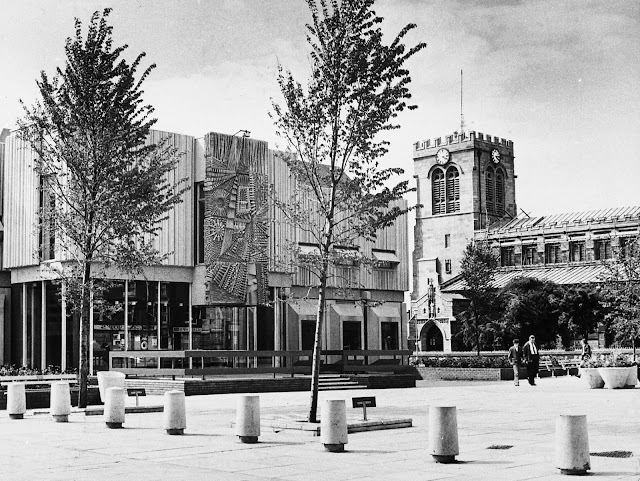Utopian Relics
 |
| The Turnpike Centre, Leigh (1972) image courtesy of Archives: Wigan & Leigh |
article taken from STAT - ISSUE 03
Modernism and Brutalism are terms which describe a wave of distinct, but related, design movements which dominated from the end of the Second World War to around the 1980s. Architecturally, these are styles of design in which the function of a building dictates its design, leading to structures of distinct form, perhaps better suited to their daily use. While contentious, I believe modernism - through its break with traditional aesthetics of design - also contains a political dimension: that the design of our environment is just as much a part of political discussion as artistic.
Take The Turnpike Centre in Leigh. Opened in 1971, it is a unique brutalist building located in what, at the time, was still an active Lancashire mining town. Unlikely to be built today - in no small part due to neoliberal shifts in political and cultural appetite - The Turnpike was a municipal building, its purpose: to serve the public as both a library and art gallery. This core value of public service is something seen across a range of modernist buildings built within the borough during a period of post-war optimism and utopian forward planning: the council offices of Wigan Civic Centre, the sports complex of Howe Bridge and the various mail and British Telecom buildings dotted across Ashton, Atherton, Leigh and Wigan.
 |
| Howe Bridge Sports Centre (1981) image courtesy of Archives: Wigan & Leigh |
The ideals represented, even among this small sample of buildings, are in stark contrast to the constructions of today - an era of veneer represented by unsafe cladding, private leisure centres cracking at their fresh seams and new build estates littered with dead trees and torn turf squares. In my 20 short years on this planet I've seen relentless attacks from successive governments on the public sphere, so it's not difficult to feel a jealousy for the period of civic idealism - albeit flawed and imperfect - of the modernist period. This utopian thinking is in complete opposition to the relentless cost-cutting and short-termism of my lifetime; most recently illustrated by the demolition of my nearest public building in 2017, Lowton Civic Hall, shortly after it was sold on to commercial interests.
The more examples of modernism provided - New Town House council offices in Warrington, Liverpool Crown Court and Royal Hospital, and countless university buildings across the North - the more inseparable the movement seems from an ideology of idealism, collectivism and public-ownership.
 |
| Scholes high-rise estate, Wigan |
Subsequently, it angers me to recall school study on the decline of the Scholes high-rise estate during the 80s and 90s. Often, along with other similar estates, this decline is portrayed as being isolated from outside political forces and instead a deterioration the blame of the estate’s design and residents. While it may be easy to blame egotistical architects, influxes of wrong-doers or residents "without pride", it's often less the building or residents that are to blame, more the political destruction of the ideas these buildings represented and their subsequent neglect.
It is no coincidence that modernist and utopian movements withered away into the 1980s during Thatcher’s destructive embrace of free-market capitalism. This was the stake in the heart of an optimistic post-war collectivism and the tightening of the public purse, mass unemployment and widened wealth inequality of this period remains to this day. On investigation of the political forces at work during this era, it seems obvious that neglect, privatisation and individualistic economics would have much greater and more plausible effect on the decline of such modernist estates over the aesthetic breakaway from classic design principles.
 |
| Wigan Civic Centre |
At the very least, the post-war period had the vague dream of the ideal society and made gains toward this through ideologically inseparable public work projects. By comparison, the last twenty years have seen - at least pre-Corbyn - an abandonment of idealism in favour of relentless so-called 'pragmatism', resulting in the inability to imagine a utopian society; only a slightly better version of now. Idealism can only be fought for with opposing ideals. If we are to have any hope of improving both our material and cultural conditions, then we must be uncompromising in imagining a radically better world in both society and the built environment.
